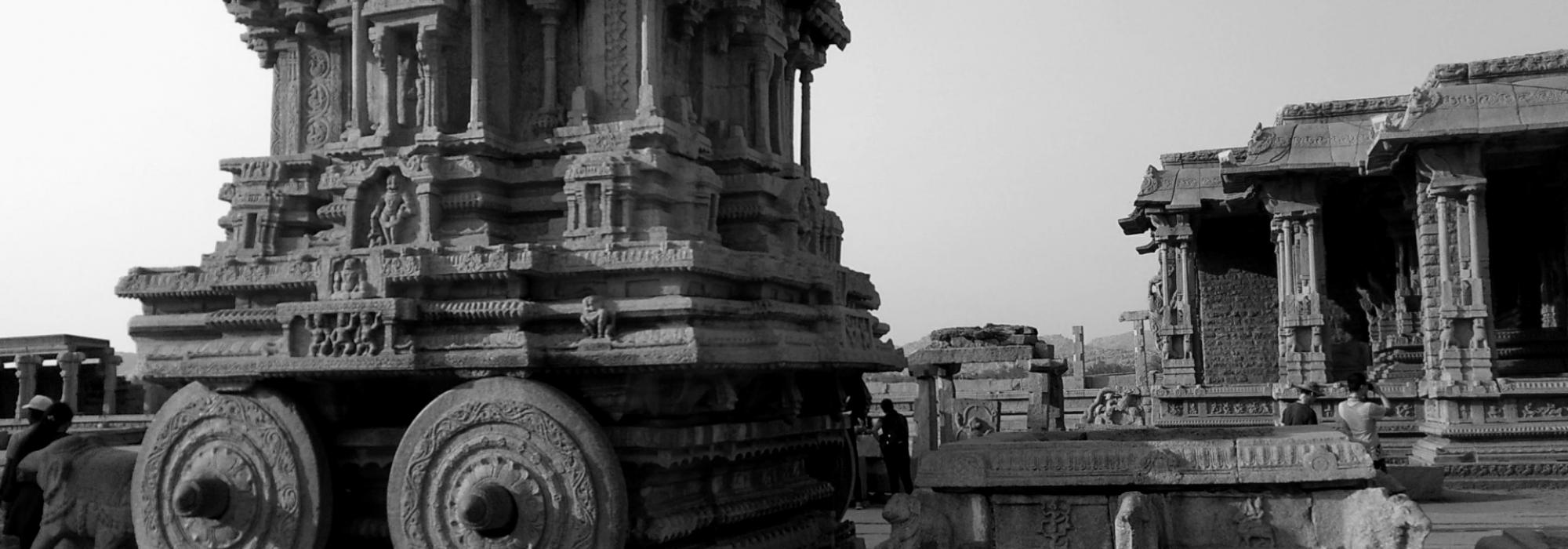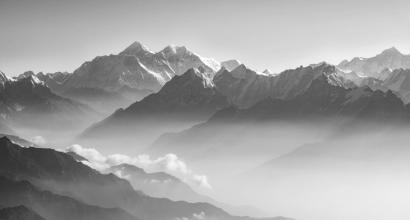In its original and purest form, Hinduism is a sanatana dharma, loosely translated as ‘eternal truth’ or ‘timeless religion’ or ‘eternal way of life’ or ‘timeless ethic.’ It is drawn from nature and thus unrestricted by space-time constraints. However, in the several applications of sanatana dharma, we adopt specific spatiotemporal frames.
The word सनातन—sanatana—symbolizes eternity. From linguistic and cultural viewpoints, the word sanatana is a symbol of an unbiased, non-dogmatic, universal spirit. The word धर्म—dharma—does not have a proper equivalent in languages other than Sanskrit (or its derivatives). Its spirit can be loosely communicated in English with words such as ‘global ethic,’ ‘righteousness,’ ‘way of life,’ ‘culture,’ ‘principle,’ ‘law,’ ‘duty,’ and so on. All these words put together signify the sustained implications of dharma. The term ‘Indian culture’ is a reasonable approximation to sanatana dharma.
Before going into the study of sanatana dharma, we shall begin a rational enquiry into values. Any faith or belief system should not be left unchallenged and we must screen it through rational enquiry and by gaining the universal experience firsthand. Without undergoing this experience, all our efforts will go waste.
Consciousness
Our perception of the world at different levels depends on us; the process of understanding depends on our mental and physical faculties. Thus our every enquiry in any field of our choice invariably presumes the self-evident existence of ourselves and proceeds from there on.
Can we question our own existence? If so, it stands to reason that even such questions will be the product of our own existence. Therefore, our existence – irrespective of its kind – is eternal as far as we are concerned. Though our experiences in the wakeful state or even in the dream state are entirely different from place to place, time to time, person to person, and thought to thought, in sound sleep all of us have the same experience of absolute immersion and absolute detachment. Sleep is a highly refreshing and blissful state indeed.
None of the differences pertaining to natural or human-made divisions such as gender, race, age, nationality, or economic-social-cultural diversities are felt in this state. Only in the states of wakefulness and dream do we have the baggage of ourselves. In the wakeful state, the sense organs and the mind are active but in the dream state, only the mind is active. Of course, it must be said here that we are speaking with a bias towards the wakeful state, because when we are dreaming, we feel the existence of body, and the overall physicality of the experience is indisputable.
In the state of sound sleep, neither the sense organs nor the mind are in action. However, there is no paucity of bliss. There is absolutely no sense of inadequacy. It is a state of complete fulfillment. For our enquiry, we should start our analysis from this point. No study will become meaningful without a common or universal basis such as this, to compare and contrast with any other experience. The Upanishads start their self-enquiry with this analysis.
Purusharthas
In deep sleep, there is no possibility for desires to arise. But in the dream and wakeful states, there is a great play of desires and dissolutions, proposals and disposals and agreements and disagreements.
Desire is the starting point of our individuality, or rather the feeling of our existence and identity. Desires drive us to action, which is essential to fulfill them. Desire stems from insufficiency because it is the incompleteness within us that drives us to obtain something. In chemistry, unsaturated elements in terms of the number of electrons in their outermost orbit become chemically reactive and try hard to become saturated. This is the concept of valence of atoms. Similarly, our desires, according to their valences, trigger action.
According to traditional wisdom, this sequence of incompleteness leading to desire eventually ending in activity is termed as the chain of avidya (ignorance), kama (desire) and karma (action). Those who do not feel this incompleteness will not get caught in this downward spiral.
In the idiom of economics, desire leading to activity can be understood as demand leading to supply. In the long run, supply can never catch up with demand because the human mind always harbors desires and demand is not constrained by materialistic limitations. This is not the case with supply.
Typically, our desires get fulfilled in the material world and hence their existence is spatiotemporal in nature. Desire, which is psychological in origin and physical in manifestation, always has an upper hand over the things which try to satisfy it because the agencies which try to meet with the desire are constrained by matter, energy, space, and time. There will always be an acute shortage of supply against perpetual demand. We are aware that today we witness the rapid depletion of natural resources at one end and an unlimited, ruthless world of desires constantly escalating at the other end.
In sanatana dharma, the idea of demand and supply is conceived as kama and artha. Kama refers to desires and artha refers to the means of satisfying desire.
If desire goes on a rampage in a blind quest for gratification, the world will come to a halt in seconds. This doesn’t happen because of the compromise – willing or unwilling – that we have made within and among ourselves. We agree to abide by the rules that we have ourselves set for the smooth functioning of our societies. This compromise evolves naturally because without it, our own existence is threatened. There is no doubt that such a compromise will not be pleasing to everyone; it is always the second-best choice in any situation (the best being what is solely convenient to us). The mode of implementation of this compromise will differ according to the frames of time, space, and mind set.
If this compromise is enforced from outside, it becomes a rule or an order. When it is realized from within, it becomes responsibility and awareness. Sanatana dharma calls this compromise, which is both a rule and a realization, as dharma.
These three concepts – kama, artha, and dharma – are termed ‘trivarga’ (the group of three) and we may realize them in the physical world. The fourth concept, moksha (loosely translated as ‘liberation,’ ‘salvation,’ ‘release,’ ‘bliss,’ etc.) is termed ‘apavarga’ (the separate group) and is treated separately from the other three since we have to annihilate desires and transcend the physical world in order to realize it. Moksha refers to liberation from the triad of demand, supply, and compromise.
The scriptures recommend, first of all, an efficient management of kama/demand by using artha/supply by adhering strictly to dharma/compromise. This leads to a well-rounded life with its share of work and pleasure, neither losing calmness nor becoming stoic. By doing this, we would have prepared the ground for moksha.
These four core concepts – dharma, artha, kama, moksha – are together called the purusharthas. In this context, the word purusha means ‘that which dwells in the body’ or ‘the self’ and artha refers to ‘the means’ to understand the self. This wonderful conception of purusharthas retains relevance across time and place and transcends gender, race, nationality, religion, and political ideology or identity.
Classification of Dharma
Dharma is divided into two groups: samanyadharma (general or universal principles and visheshadharma (special or particular principles).
Samayadharma includes all basic values which don’t change with space and time. They are applicable irrespective of distinctions of gender, race, caste, creed, occupation, nationality, etc. They comprise what we would call human values today – truth, non-violence, non-avariciousness, purity of thought, speech, and action, self-control, empathy, forgiveness, and so on. The sage-seer Manu defines dharma as having ten features: courage, forbearance, self-control, abstinence from stealing, cleanliness, control over senses, power of discernment, self-knowledge, integrity, and freedom from anger (Manusmrti 7.92)
Visheshadharmas are spatiotemporal in that they are relevant only for a particular time and place. Some of the visheshadharmas are ashramadharma (the traditional duties of individuals at different stages of life), varnadharma (the traditional duties of people of different temperaments), rajadharma (duties of rulers), and apaddharma (duties and exemptions applicable during adverse situations). The specific injunctions of visheshadharmas are only relevant to a particular place and time but the general notions are universally applicable. For example, the rules that were laid down for a king might not be relevant today but the idea that governance needs guidelines will remain forever. The beauty of the Indian tradition is that there has been a constant re-interpretation of these concepts to suit the changing contexts and needs of space and time. This subtle dynamism is what makes Hinduism a very robust way of life.
Irrespective of the category of dharma, the essential qualification for a true adherent of dharma is the constant accountability – here and now – of thought, word, and deed. There is no place for a preacher who does not practice where dharma is concerned. One of the words for teacher in Sanskrit is acharya, which means one who himself adheres to the principles that he espouses. The acharya is truly aware of what he is teaching. Indeed the aspects of learning, teaching, and practising merge in one who is a true acharya.
Another interesting aspect of dharma in the Indian tradition is that it doesn’t blindly toe the line of morality. It judges from a philosophical perspective and not a mere materialistic one. For example, being honest normally refers to verbal sincerity and being non-violent refers to not hurting others. These values maybe transgressed for a greater cause – a son might lie to his aged mother to save her from a rude shock, a police officer might violate traffic rules while chasing a criminal, a surgeon might amputate a patient’s leg to save the latter’s life, a teacher might punish a student to help him mend his ways. Can these be counted as cases of dishonesty or violence?
In such cases, we naturally consider the intent of the people involved and the results of their action. In this regard, sanatana dharma upholds the actions of people who are selfless and self-realized with good intentions even if their chosen means is not ‘moral’ by the textbook definition.
There is a nice episode in the Karna Parva of the Mahabharata where Arjuna and Yudhishtira are having a heated argument with regard to maintaining their oaths. Krishna pacifies them by giving them an exposition on the nature of truth and declares – “यत् भूतहितमत्यन्तम् तत् सत्यमिति धारणा” (Truth is that which is good for all beings, that which is good at the universal level).
Fact and Value
The seers of ancient India gave importance to the implications of facts and values both within and outside the purview of faith. On the one hand, they did not completely exclude faith from philosophy and on the other hand, they did not try to explain everything within the narrow framework of faith. They approached facts and values from logical and intuitive, emotional and intellectual, practical and mystical, realistic and idealistic, and materialistic and spiritualistic perspectives. Therefore, their understanding of fact and value has been free from biases and are thus applicable universally.
And so the obvious question that arises is: What separates facts and values? We always comprehend facts because they are perceived through the senses. There is not much to discuss or argue with regard to facts. They are objective. However, we realize values through our experience and hence there arise several diverging opinions and views, which are subjective.
Facts deal with the external world whereas values are intrinsic. If facts are what we encounter, values are what we reflect upon. If facts are grasped by the intellect, values are realized through experience.
Values are not ready-made or even fabricated like facts. Facts are an ever-growing body of data from the world around us. We rarely gather facts for the heck of it; facts are often used for purposes other than themselves. However, values are almost always pursued for their own sake. Further, once we understand a fact, it need not concern us or relate to our life. But that is not the case with values. Once it has come within the grasp of our understanding, it has indeed become a part of our experience. If that is not the case, then we have not truly realized the value but instead have only intellectually grasped the idea.
The non-materialistic nature of values makes them elusive in the material world. Values are not perceived through our physical senses but are felt in our consciousness. Let us take a simple example of a glass of water. The water is a fact and so is the glass. Where the water came from, and how the glass was fashioned, are also facts. But drinking the water and quenching our thirst is the realization of the value of thirst.
Continued in the next part.
Adapted from the author’s article Foundations of Sanatana Dharma, translated from the original Kannada by K B S Ramachandra. Edited by Sandeep Balakrishna.




































